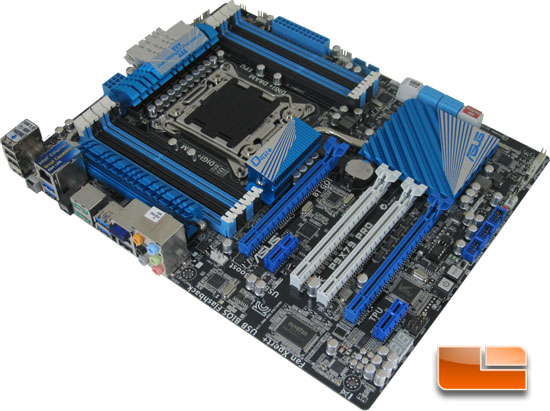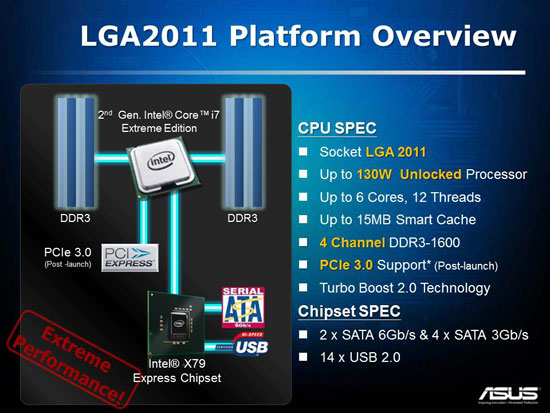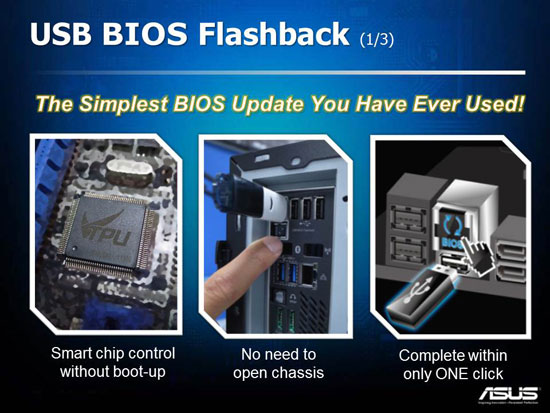ASUS P9X79 Pro Intel X79 Motherboard Review
ASUS P9X79 Pro X79 Motherboard

So which comes first? The chicken or the egg? We can’t have a review of the ASUS P9X79 Pro Intel X79 motherboard without a new Intel Sandy Bridge-E processor, can we? Of course we can’t launch the new Intel X79 Express chipset without a review of the LGA2011 processor! So, while Nate has been working hard on the processor review of the Intel Core i7 3960X which he has so eloquently put together for us here, we will be taking a look at one of the first Intel X79 motherboards from ASUS, the ASUS P9X79 Pro! The work Nate is doing is focusing more on the performance of the new Intel Core i7 3960 Sandy Bridge E processor, while we will be focusing on the performance and features of the ASUS P9X79 Pro LGA2011 motherboard and the Intel X79 chipset. We will be taking a look at the performance scaling in NVIDIA SLI and AMD CrossFireX as well as the performance of the integrated SATA III 6Gbps and SuperSpeed USB 3.0. Since this is the first Intel X79 to pop up on our radar, we are going to compare it to a handful of systems from both AMD and Intel!
In the tradition of ASUS, they will be releasing a number of LGA2011 motherboards right out of the gate. Each of them will have a different feature set as well as a different price point. The entry level ASUS motherboard will be the ASUS P9X79 and will have a suggested retail price of $299.00. The ASUS P9X79 Pro is the first step up and will retail for $329.00; the Deluxe version of the ASUS P9X79 will have an expected retail price of $399.00. The TUF series of motherboards isn’t being forgotten about for the Intel X79 chipset; ASUS will have a Sabertooth X79 available for $339.00. If you are looking for the ultimate board and are willing to spare no expense, ASUS is releasing their new Republic of Gamers Rampage IV Extreme at $459.00.

The Intel X79 Express chipset is an all new platform. It is designed to replace the aging X58 platform which is the previous ‘enthusiast’ platform. Earlier in the year Intel released the P67 platform and followed that up with the Intel Z68 platform. Both of these chipsets were aimed at the mainstream crowd but they proved to be a solid competitor for the X58 platform. The LGA1155 platform has a couple of processors that proved to be phenomenal overclockers. The Intel Core i7 2600K and the Intel Core i5 2500K both had unlocked processors and we have seen them running at 5+GHz on air cooling! One of the advantages to the new Sandy Bridge-E processors is the 6 core 12 thread aspect. The top LGA1155 processor is the Intel Core i7 2700K and is a quad core processor plus hyper-threading. While there really aren’t any PCIe 3.0 capable cards out there right now, ASUS Intel X79 motherboards are PCIe 3.0 ready. All of the PCIe X16 slots are PCIe 3.0 ready.

Intel opted not to include the Smart Response Technology on the Intel X79 Express chipset. It isn’t a feature that I have been wild about, but that may just be me. If you are though, and you’re a bit disappointed that Intel isn’t including it with the X79 chipset, ASUS has you covered. ASUS has implemented their own technology to accomplish the same feature. The ASUS SSD Caching is geared to be much simpler than the Intel SRT. Simply plug your SSD and hard drive in to the Marvell controlled SATA III 6Gbps ports, fire up AI Suite II and enable the ASUS SSD Caching. It is pretty simple, and you will get SSD like speeds without the size limitations of a low cost SSD.

If you are new to the ASUS UEFI BIOS, you’re likely to get a little lost when you’re looking for a specific setting. If you’re a veteran user, you may just find this new option from ASUS a new favorite. When you hit the shortcut key (F3) it will bring up a dialog window that will allow you to jump to whichever page you are looking for. Whether you need to jump to the ASUS EZ Flash 2 Utility, tweak your memory timings or change the DIGI+ Power settings you can easily find what you need.

ASUS has a feature that is quite unique to their motherboards. If you have ever had a motherboard that wasn’t posting correctly, and you needed to update the BIOS but couldn’t because of a hardware conflict that was resolved in a later BIOS version, you were pretty much out of luck unless you had extra hardware lying around to swap out. ASUS has remedied that situation with the ASUS BIOS Flashback! Now all that you need to update the BIOS on many of the ASUS motherboards is a USB flash drive, the motherboard and a power supply. You don’t need to have any other hardware installed! Insert the flash drive, and hit the button on the I/O panel and you’re good to go.

ASUS has made SuperSpeed USB3.0 even faster with the use of ASUS USB 3.0 Boost. Using UASP which is short for USB Attached SCSI Protocol, ASUS was able to increase the performance of the ASMedia USB 3.0 controller that they use on the ASUS P9X79 Pro motherboard. You simply need a device that will support the UASP protocol and the latest build of AI Suite II to enable it and away you go. From their internal testing it is up to 170% faster than traditional USB 3.0.

If you have ever used the ASUS AI Suite II, you know how useful it can be. If you haven’t used it, give it a go. It has been redesigned and has a very user friendly interface. Using the ASUS AI Suite II you have access to many of the features in the UEFI BIOS. You will be able to adjust the Bclk frequency, multiplier and voltages through the TurboV EVO controls. Control your fans with the Fan Xpert+, enable the USB Boost and SSD Caching, and manage the DIGI+ Power Control.

Comments are closed.